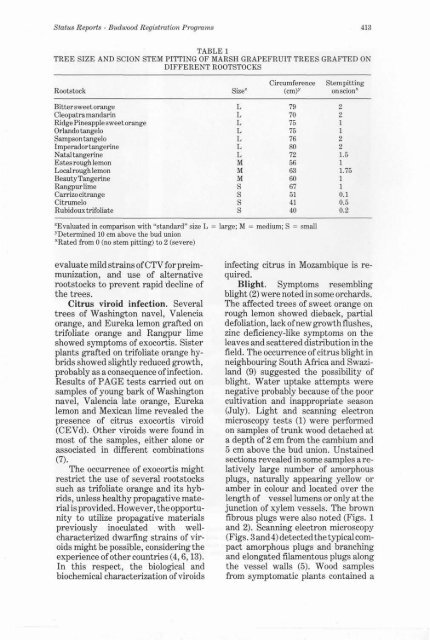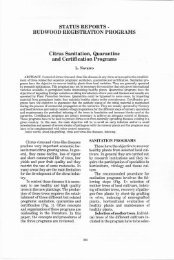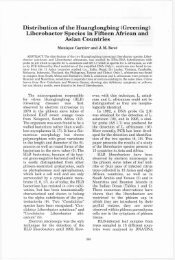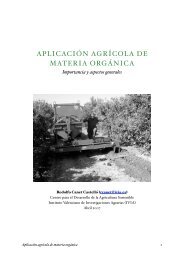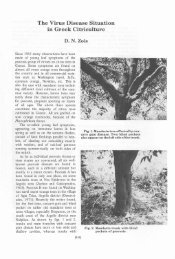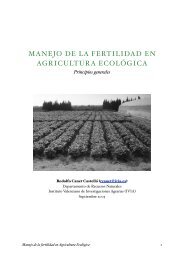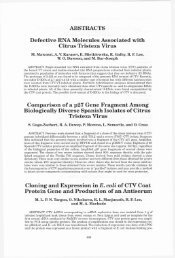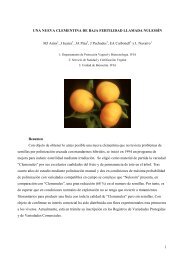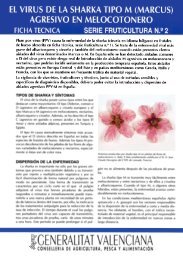A. Catara, C. Laviola, M. Davino and V. Grimaldi - IVIA
A. Catara, C. Laviola, M. Davino and V. Grimaldi - IVIA
A. Catara, C. Laviola, M. Davino and V. Grimaldi - IVIA
Create successful ePaper yourself
Turn your PDF publications into a flip-book with our unique Google optimized e-Paper software.
Status Reports - Budwood Registration Programs 413<br />
TABLE 1<br />
TREE SIZE AND SCION STEM PITTING OF MARSH GRAPEFRUIT TREES GRAFTED ON<br />
DIFFERENT ROOTSTOCKS<br />
Rootstock<br />
Circumference Stempitting<br />
Sizez (em)y on scionx<br />
Bitter sweet orange<br />
Cleopatram<strong>and</strong>arin<br />
Ridge Pineapple sweel<br />
Orl<strong>and</strong>o tangelo<br />
Sampson tangelo<br />
Imperadortangerine<br />
Natal tangerine<br />
Estes rough lemon<br />
Local rough lemon<br />
Beauty Tangerine<br />
Rangpurlime<br />
Carrizo citrange<br />
Citrumelo<br />
Rubidoux trifoliate<br />
'Evaluated in comparison with "st<strong>and</strong>ard" size L = large; M = medium; S = small<br />
YDetermined 10 cm above the bud union<br />
"Rated from 0 (no stem pitting) to 2 (severe)<br />
evaluate mild strains of CTV for preimmunization,<br />
<strong>and</strong> use of alternative<br />
rootstocks to prevent rapid decline of<br />
the trees.<br />
Citrus viroid infection. Several<br />
trees of Washington navel, Valencia<br />
orange, <strong>and</strong> Eureka lemon grafted on<br />
trifoliate orange <strong>and</strong> Rangpur lime<br />
showed symptoms of exocortis. Sister<br />
plants grafted on trifoliate orange hybrids<br />
showed slightly reduced growth,<br />
probably as a consequence of infection.<br />
Results of PAGE tests carried out on<br />
samples of young bark of Washington<br />
navel, Valencia late orange, Eureka<br />
lemon <strong>and</strong> Mexican lime revealed the<br />
presence of citrus exocortis viroid<br />
(CEVd). Other viroids were found in<br />
most of the samples, either alone or<br />
associated in different combinations<br />
(7).<br />
The occurrence of exocortis might<br />
restrict the use of several rootstocks<br />
such as trifoliate orange <strong>and</strong> its hybrids,<br />
unless healthy propagative material<br />
is provided. However, the opportunity<br />
to utilize propagative materials<br />
previously inoculated with wellcharacterized<br />
dwarfing strains of viroids<br />
might be possible, considering the<br />
experience of other countries (4,6,13).<br />
In this respect, the biological <strong>and</strong><br />
biochemical characterization of viroids<br />
infecting citrus in Mozambique is required.<br />
Blight. Symptoms resembling<br />
blight (2) were noted in some orchards.<br />
The affected trees of sweet orange on<br />
rough lemon showed dieback, partial<br />
defoliation, lack of new growth flushes,<br />
zinc deficiency-like symptoms on the<br />
leaves <strong>and</strong> scattered distribution in the<br />
field. The occurrence of citrus blight in<br />
neighbouring South Africa <strong>and</strong> Swazil<strong>and</strong><br />
(9) suggested the possibility of<br />
blight. Water uptake attempts were<br />
negative probably because of the poor<br />
cultivation <strong>and</strong> inappropriate season<br />
(July). Light <strong>and</strong> scanning electron<br />
microscopy tests (1) were performed<br />
on samples of trunk wood detached at<br />
a depth of 2 cm from the cambium <strong>and</strong><br />
5 cm above the bud union. Unstained<br />
sections revealed in some samples arelatively<br />
large number of amorphous<br />
plugs, naturally appearing yellow or<br />
amber in colour <strong>and</strong> located over the<br />
length of vessel lumens or only at the<br />
junction of xylem vessels. The brown<br />
fibrous plugs were also noted (Figs. 1<br />
<strong>and</strong> 2). Scanning electron microscopy<br />
(Figs. 3 <strong>and</strong>4) detected the typical compact<br />
amorphous plugs <strong>and</strong> branching<br />
<strong>and</strong> elongated filamentous plugs along<br />
the vessel walls (5). Wood samples<br />
from symptomatic plants contained a


